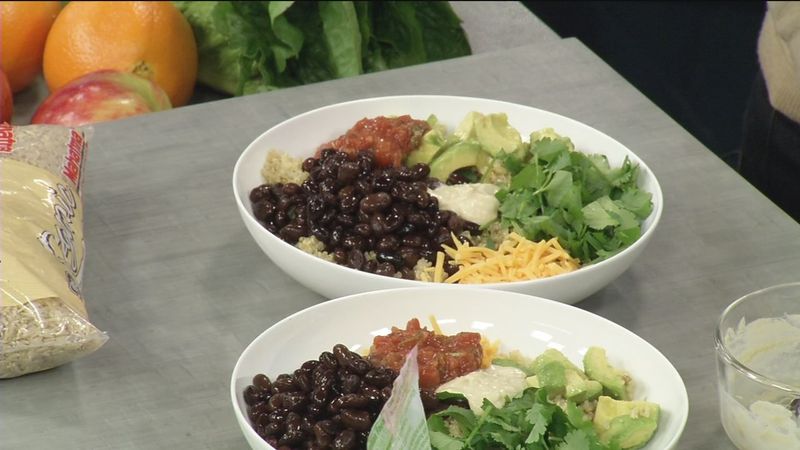Quinoa Makes for An Easy Meal That's Heart Healthy Too

Black Bean-Quinoa Bowl
LOUISVILLE, Ky. (WDRB) - February is heart health month. The American Heart Association says while you can't change things like age and family history, you can make small changes to your diet and lifestyle to improve your heart health and lower your risk by as much as 80 percent.
Catherine Arnold, known as the Mindful Dietician, offers the following simple tips to help improve your family’s diet and eating habits: increase your fiber, be smart about fats, and add some high fiber meals into your weekly dinner cycle.
Choose foods with more fiber:
What is dietary fiber?
- The part of plant foods that your body cannot digest.
Where is fiber found?
- Mainly in fruits, vegetables, whole grains, legumes (dried beans and peas), nuts and seeds.
Health Benefits of fiber:
- Reduce high blood cholesterol
- Reduce high blood pressure
- Manage body weight by helping you feel full longer
How much fiber do I need?
- Women under 50 need 25 grams. Over 50 need 21 grams
- Men under 50 need 38 grams. Under 50 need 32 grams
- Most Americans eat 16 grams per day
Ways to increase fiber in diet
- Eat more whole grains. Try different types of whole grains for variety – like barley, kasha, bulgur, quinoa, wild rice, and couscous. Also try other pasta varieties – like whole wheat, brown rice or quinoa pastas.
- Look for “high in fiber” or “excellent source of fiber” on the package, which indicates there are 5 or more grams of fiber per serving.
- Eat more fruits and vegetables – at least 2 cups of fruit and 2-1/2 cups of vegetables each day.
- Choose whole (fresh, frozen or dried) vegetables and fruits over juices, which have most of the fiber removed.
- Include legumes (i.e., dried beans and peas) with your meals regularly.
- Add a crunch by sprinkling high fiber cereal (i.e., 100% bran) onto yogurt, fresh fruit, and frozen yogurt.
- Substitute whole wheat flour for at least 1/3 of the all-purpose flour in baked goods recipes.
- Order or make your own pizza with a whole wheat crust and with vegetable toppings such as spinach, tomatoes, broccoli, mushroom, onion, roasted red pepper and/or green pepper.
- Add frozen vegetables to soups, sauces, casseroles or pasta dishes.
Be smart about fats:
Reduce how much saturated fat and cholesterol you eat: The AHA recommends you decrease your intake of saturated fat and increase intake of Mono and Polyunsaturated fats.
- Saturated fats occur naturally in many foods. Usually solid at room temperature, the majority come mainly from animal sources, including meat and dairy products. Saturated fats increase the level of total cholesterol and LDL (bad) cholesterol in your blood. High levels of blood cholesterol increase your risk of heart disease and stroke.
Saturated fat raises your LDL cholesterol level more than anything else you eat. It is found in:
- Fatty cuts of meat
- Poultry with skin
- Whole-milk dairy products
- Tropical oils, such as coconut, palm kernel, and palm oils
- Fried foods
- Cream
- Many snacks and sweets
Tips:
- Use liquid vegetable oils in place of solid fats like butter, margarine, and shortening
- Drink skim or low fat milk and eat lower fat dairy
- Remove visible fat and skin from meat and poultry
- Use fewer commercial pastries, cookies, cakes, pies, and doughnuts
- Limit processed meats like bacon, sausage, and hot dogs
- Incorporate healthy fats. Both mono and polyunsaturated fats promote heart health by improving the good cholesterol and helping lower the bad cholesterol.
Monounsaturated: By replacing saturated fats with monounsaturated fat you can lower your LDL cholesterol and increase your HDL cholesterol. Olive oil, canola oil, peanut butter and avocados are good choices because they are high in monounsaturated fats.
Omega-3 fatty acids are another type of healthy fat (polyunsaturated). Foods rich in omega-3 fatty acids include salmon, tuna, flaxseed, and walnuts.
Black Bean-Quinoa Bowl (serves 4)
This black bean and quinoa Buddha bowl has the usual hallmarks of a taco salad, minus the greasy fried bowl. It's loaded with pico de gallo, fresh cilantro and avocado, plus an easy hummus dressing to drizzle on top.
Ingredients:
- 1-15 oz can black beans, rinsed
- 2 cups cooked quinoa
- ½ cup hummus
- 3 tablespoons lime juice
- 1 medium avocado, diced
- ½ cup pico de gallo
- ¼ cup chopped fresh cilantro
- ¼ cup shredded sharp cheddar cheese
- You can add shredded chicken from rotisserie chicken or grilled skinless chicken breast
Directions:
- Combine beans and quinoa in a bowl. Stir hummus and lime juice together in a small bowl. Drizzle the hummus dressing over the beans and quinoa.
- Top with avocado, pico de gallo, cheese, and cilantro.?
Story Credit: http://www.wdrb.com/story/37536503/quinoa-makes-for-an-easy-meal-thats-heart-healthy-too


